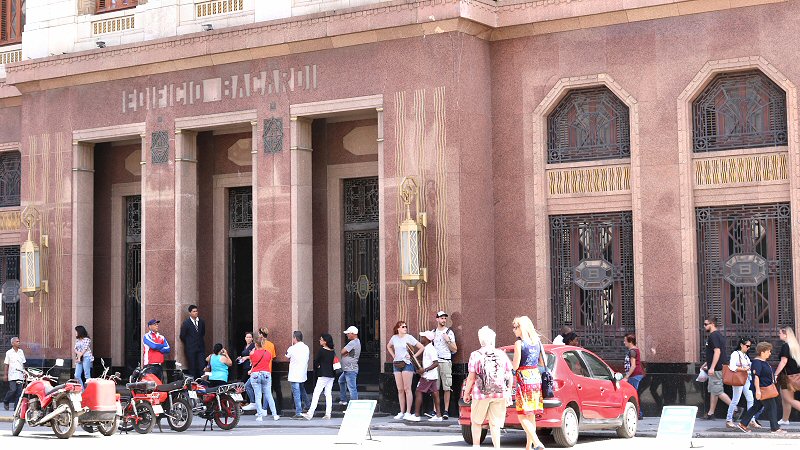
It is considered the first Art Deco
building in Havana, undoubtedly the finest one in this style in
Havana. It has a ziggurat (or stepped pyramid) design,
terminating in a tower. The 47 meters-high building has 12
storeys, five of which are occupied by the offices. The total
covered area of the building is about 7.000
m2, of which about only 560 m2 are used by offices, occupying
the five floors of the building.
The facade is covered with
shiny red Bavarian granite, golden glazed tiles,
brass embellishments and glazed
terracotta reliefs of geometric patterns and flowers. These
decorative elements points at the influence of the modern
Catalonian architecture, and give a wonderful shade effect to
the building. The colorful terracotta reliefs of nude nymphs at
the top of the building were designed by the American
illustrator Maxfield Parrish. The lavishly decorated facade was
executed by Arellano y Mendoza at a cost of 500.000
pesos.
The building is topped
with the bronze sculpture of a fruit bat; it is the logo
of the Bacardí Company. When Facundo Bacardí Massó, his younger
brother José and José Leon Bouteiller
founded the Bacardí Company (Bacardí, Bouteiller y
Compañía) and opened their first distillery in Santiago de Cuba
in 1862, the new blend gained wide acceptance, as it was smooth
and mixable, in contrary to the harsh and fiery local rum.
Initially the rum was packed in containers that had been used
for an olive oil firm that was using the bat figure as its
trademark. When the consumers begun to ask the “rum of the bat”,
Amalia, Don Facundo’s wife, suggested to use the fruit bat for
the company logo, as according to Taíno belief (the native
Cuban), fruit bat symbolizes good health, good fortune and
family unit. At that time, maybe Amelia had remembered also
Facundo’s primitive distillery that were housing a large colony
of fruit bats under the tin roof. The fruit bat falls
into the category of the megabat and sometimes they are called
the flying fox in some locations. Megabats are a suborder of
bats that eat fruit. Soon the Bacardí rum was bottled with a
black bat on the label. This was a shrewd marketing tactics, as
most of the inhabitants were illiterate, but they could
recognize the rum with the trademark bat; thus, the Bacardí rum
became known also as the rum of the bat. The black bat on a red
background continues today as the distinctive logo of Bacardí
rums.
At
both sides of the entrance door there are two brass
embellishments; that one on the
left side is a stylized Art Deco version of
Havana’s coat of arms. The walls of the
portico from the floor upto the ceiling, as well as the two
halls of the bar restaurant are covered with Bavarian granite of
different colors, laid out in Art Deco pattern. In Cuba the soft
green marble was used for the first time in this building. The
gold leaf and rose-coloured, pale green and black
inlaid marble and granite was imported from different countries
of Europe, like Germany, Sweden, Norway, Italy, France, Belgium
and Hungary.
The
first floor has an area of about thousand square meters and it
is about 7 meters high. The first floor contained the famous bar
restaurant where once the Bacardí family could watch the bar
from the mezzanine with the archway, during they take their
dinner and lunch. Even though the bar witnessed many celebrities,
in fact most people in Havana didn’t even know that it existed,
as it was somewhat the private watering hole of the
Bacardi family.
The little-known bar itself is small
compared to other bars in Havana. It was made of black wood with
large gold diamond reliefs on it. The hall is illuminated by
squared Art Deco ceiling lights. Large wooden panels are
covering the walls. On all the walls are frosted glass light
sconces etched with the famous Bacardi bat. The Bacardí bat
motif can also be found throughout the building’s richly
decorated interior. The numerous windows are framed by large
forged iron grates.
The
sumptuous interior details of the building can be
summarized as the blue mirrors, stucco reliefs, polished brass
embellishments, mahogany and cedar wall panels, mural paintings
and stained glass.
The building has four
elevatores. Two elevators had a capacity for 10 persons, whereas
the third was used for the transport of the cargo, like the
furmniture, and the fourth for the transport of goods from the
basement to the bar restaurant on the first floor.
The Bacardí building is not open to the visitors, but you can take your chance to persuade the guard for a few CUC’s to visit the first floor and take the lift up to the tower for an eagle's-eye view.
Nowadays it is surrounded by other tall
buildings, so it is difficult to get a panoramic view of its
structure from the street level, but the opulent tower can be
seen from all over Havana.

